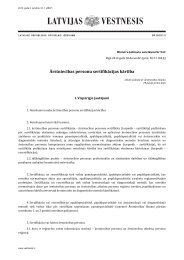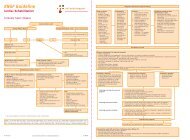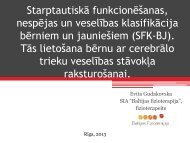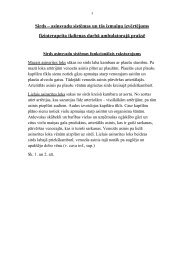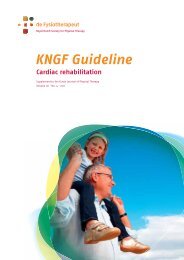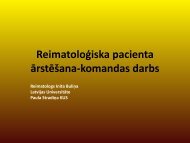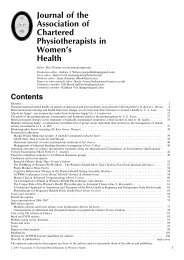You also want an ePaper? Increase the reach of your titles
YUMPU automatically turns print PDFs into web optimized ePapers that Google loves.
B<br />
<strong>Low</strong> <strong>Back</strong> <strong>Pain</strong>: Clinical Practice Guidelines<br />
CLINICAL GUIDELINES<br />
Summary of Recommendations<br />
RISK FACTORS<br />
Current literature does not support a definitive cause for initial episodes<br />
of low back pain. Risk factors are multifactorial, population<br />
specific, and only weakly associated with the development of low<br />
back pain.<br />
E<br />
CLINICAL COURSE<br />
The clinical course of low back pain can be described as acute, subacute,<br />
recurrent, or chronic. Given the high prevalence of recurrent<br />
and chronic low back pain and the associated costs, clinicians should<br />
place high priority on interventions that prevent (1) recurrences and<br />
(2) the transition to chronic low back pain.<br />
B<br />
DIAGNOSIS/CLASSIFICATION<br />
<strong>Low</strong> back pain, without symptoms or signs of serious medical or<br />
psychological conditions, associated with clinical findings of (1)<br />
mobility impairment in the thoracic, lumbar, or sacroiliac regions,<br />
(2) referred or radiating pain into a lower extremity, and (3) generalized<br />
pain, is useful for classifying a patient with low back pain into<br />
the following International Statistical Classification of Diseases and<br />
Related Health Problems (ICD) categories: low back pain, lumbago,<br />
lumbosacral segmental/somatic dysfunction, low back strain, spinal<br />
instabilities, flatback syndrome, lumbago due to displacement<br />
of intervertebral disc, lumbago with sciatica, and the associated<br />
International Classification of Functioning, Disability, and Health<br />
(ICF) impairment-based category of low back pain (b28013 <strong>Pain</strong> in<br />
back, b28018 <strong>Pain</strong> in body part, specified as pain in buttock, groin,<br />
and thigh) and the following, corresponding impairments of body<br />
function:<br />
• Acute or subacute low back pain with mobility deficits (b7101 Mobility<br />
of several joints)<br />
• Acute, subacute, or chronic low back pain with movement coordination<br />
impairments (b7601 Control of complex voluntary<br />
movements)<br />
• Acute low back pain with related (referred) lower extremity pain<br />
(b28015 <strong>Pain</strong> in lower limb)<br />
• Acute, subacute, or chronic low back pain with radiating pain<br />
(b2804 Radiating pain in a segment or region)<br />
• Acute or subacute low back pain with related cognitive or affective<br />
tendencies (b2703 Sensitivity to a noxious stimulus, b1522 Range<br />
of emotion, b1608 Thought functions, specified as the tendency<br />
to elaborate physical symptoms for cognitive/ideational reasons,<br />
b1528 Emotional functions, specified as the tendency to elaborate<br />
physical symptoms for emotional/affective reasons)<br />
• Chronic low back pain with related generalized pain (b2800 Generalized<br />
pain, b1520 Appropriateness of emotion, b1602 Content<br />
of thought)<br />
The ICD diagnosis of lumbosacral segmental/somatic dysfunction<br />
and the associated ICF diagnosis of acute low back pain with mobil-<br />
a44 | april 2012 | volume 42 | number 4 | journal of orthopaedic & sports physical therapy<br />
ity deficits are made with a reasonable level of certainty when the<br />
patient presents with the following clinical findings:<br />
• Acute low back, buttock, or thigh pain (duration of 1 month or less)<br />
• Restricted lumbar range of motion and segmental mobility<br />
• <strong>Low</strong> back and low back–related lower extremity symptoms reproduced<br />
with provocation of the involved lower thoracic, lumbar, or<br />
sacroiliac segments<br />
The ICD diagnosis of lumbosacral segmental/somatic dysfunction<br />
and the associated ICF diagnosis of subacute low back pain with<br />
mobility deficits are made with a reasonable level of certainty when<br />
the patient presents with the following clinical findings:<br />
• Subacute, unilateral low back, buttock, or thigh pain<br />
• Symptoms reproduced with end-range spinal motions and<br />
provocation of the involved lower thoracic, lumbar, or sacroiliac<br />
segments<br />
• Presence of thoracic, lumbar, pelvic girdle, or hip active, segmental,<br />
or accessory mobility deficits<br />
The ICD diagnosis of spinal instabilities and the associated ICF diagnosis<br />
of acute low back pain with movement coordination impairments<br />
are made with a reasonable level of certainty when the patient<br />
presents with the following clinical findings:<br />
• Acute exacerbation of recurring low back pain and associated (referred)<br />
lower extremity pain<br />
• Symptoms produced with initial to mid-range spinal movements<br />
and provocation of the involved lumbar segment(s)<br />
• Movement coordination impairments of the lumbopelvic region<br />
with low back flexion and extension movements<br />
The ICD diagnosis of spinal instabilities and the associated ICF<br />
diagnosis of subacute low back pain with movement coordination<br />
impairments are made with a reasonable level of certainty when the<br />
patient presents with the following clinical findings:<br />
• Subacute exacerbation of recurring low back pain and associated<br />
(referred) lower extremity pain<br />
• Symptoms produced with mid-range motions that worsen with<br />
end-range movements or positions and provocation of the involved<br />
lumbar segment(s)<br />
• Lumbar segmental hypermobility may be present<br />
• Mobility deficits of the thorax and pelvic/hip regions may be<br />
present<br />
• Diminished trunk or pelvic-region muscle strength and endurance<br />
• Movement coordination impairments while performing self-care/<br />
home management activities<br />
The ICD diagnosis of spinal instabilities and the associated ICF diag-



